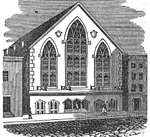One Beacon Street

One Beacon Street is a modern skyscraper in the Government Center neighborhood of Boston, Massachusetts. Built in 1972 and refurbished in 1991, it is Boston's 16th-tallest building, standing 505 feet (154 m) tall, and housing 37 floors. Its position near the top of Beacon Hill gives the building a commanding presence, though it is located away from many other Boston skyscrapers. The tower houses a broadcast mast on the roof, painted red and white. With its broadcast mast included, One Beacon Street is the 4th-tallest building in Boston (when measuring to pinnacle height), rising 623 feet (190 m). Apart from the mast, the roof of the building is flat and has no crown.
Excerpt from the Wikipedia article One Beacon Street (License: CC BY-SA 3.0, Authors, Images).One Beacon Street
Beacon Street, Boston Beacon Hill
Geographical coordinates (GPS) Address External links Nearby Places Show on map
Geographical coordinates (GPS)
| Latitude | Longitude |
|---|---|
| N 42.35844 ° | E -71.06083 ° |
Address
One Beacon Street
Beacon Street 1
02108 Boston, Beacon Hill
Massachusetts, United States
Open on Google Maps








